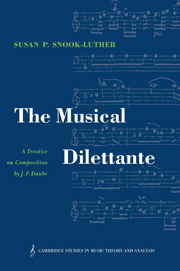Book contents
- Frontmatter
- Contents
- Foreword
- Translator's preface
- Introduction
- THE MUSICAL DILETTANTE: A TREATISE ON COMPOSITION (1773)
- Preface
- 1 Harmony in general
- 2 The three different motions of the voices
- 3 Combining two voices
- 4 Combining three voices
- 5 Combining four voices
- 6 Composition in five and more parts
- 7 Variation
- 8 Imitation
- 9 Canon
- 10 Simple fugue
- 11 Double counterpoint
- 12 Double fugue
- Bibliography
- Index
7 - Variation
Published online by Cambridge University Press: 15 October 2009
- Frontmatter
- Contents
- Foreword
- Translator's preface
- Introduction
- THE MUSICAL DILETTANTE: A TREATISE ON COMPOSITION (1773)
- Preface
- 1 Harmony in general
- 2 The three different motions of the voices
- 3 Combining two voices
- 4 Combining three voices
- 5 Combining four voices
- 6 Composition in five and more parts
- 7 Variation
- 8 Imitation
- 9 Canon
- 10 Simple fugue
- 11 Double counterpoint
- 12 Double fugue
- Bibliography
- Index
Summary
Strictly speaking, this discussion does not pertain to the [process of] combining the voices, in that it is more concerned with melody. But since the [technique of] variation is also based on harmony, which in turn is bound up with it so closely that neither can exist without the other, we have considered it necessary to insert this [discussion] here. It is certain that artificial constructions of all types of fugues, alia breve, canons, etc. depend on this [technique]. How can one write a melody to a bass theme without a basic knowledge of the art of variation? As has been said already, variations flow from the chords themselves, but with the distinction that the passing tones participate on an equal basis with the proper chord tones. Whereas we also have proposed to describe as clearly as possible the artificial style of composing fugues etc., this discussion will serve simultaneously as a preparation, especially since the proper use of variation has, as yet, very seldom been examined and explained. In the future we will show that even the invention of melody may, in part, be traced to the art of variation. Here we must use the foregoing method, taking up each interval under the instruction in its corresponding harmony. We will take the key of G major as an example.
- Type
- Chapter
- Information
- The Musical DilettanteA Treatise on Composition by J. F. Daube, pp. 132 - 143Publisher: Cambridge University PressPrint publication year: 1992



